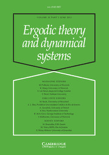
ERGODIC THEORY AND DYNAMICAL SYSTEMS
Scope & Guideline
Illuminating the Path of Ergodic Theory
Introduction
Aims and Scopes
- Ergodic Theory:
The journal emphasizes the study of ergodic properties of dynamical systems, including mixing, recurrence, and invariant measures, which are fundamental to understanding long-term behavior in chaotic systems. - Dynamical Systems:
It covers a wide spectrum of dynamical systems, from smooth and topological systems to those governed by algebraic or probabilistic rules, fostering a rich dialogue between different mathematical areas. - Symbolic Dynamics:
The exploration of symbolic dynamics is a key theme, examining how symbolic representations can simplify the analysis of complex dynamical behavior. - Geometric Dynamics:
The journal includes studies on geometric aspects of dynamical systems, such as flows on manifolds and the role of geometry in dynamical behavior. - Statistical Mechanics:
Research on connections between dynamical systems and statistical mechanics is prominent, exploring how dynamical properties relate to thermodynamic concepts. - Topological Dynamics:
The journal engages with topological dynamics, investigating the behavior of continuous transformations on topological spaces. - Applications to Other Fields:
It also looks at applications of ergodic theory and dynamical systems in various fields such as number theory, geometry, and mathematical physics, showcasing its interdisciplinary relevance.
Trending and Emerging
- High-Dimensional Dynamics:
There is a growing focus on high-dimensional dynamical systems, which are increasingly recognized for their complex behavior and implications in various mathematical fields. - Non-linear Dynamics:
Research on non-linear dynamics is on the rise, exploring chaotic behavior, bifurcations, and stability in systems that do not conform to linearity. - Interdisciplinary Applications:
Emerging themes include the application of dynamical systems to fields such as biology, economics, and physics, showcasing the versatility of dynamical systems in modeling real-world phenomena. - Random Dynamical Systems:
The study of random dynamical systems is gaining traction, reflecting an interest in understanding how randomness interacts with deterministic systems. - Topological and Geometric Aspects:
An increasing number of publications are exploring the topological and geometric structures underlying dynamical systems, emphasizing their role in understanding dynamics. - Ergodic Optimization:
The emerging focus on ergodic optimization is indicative of a trend towards understanding how to optimize dynamical systems under ergodic measures, which has implications for both theory and applications.
Declining or Waning
- Elementary Ergodic Methods:
There is a noticeable decrease in papers employing elementary methods in ergodic theory, with a shift towards more advanced, abstract approaches that leverage modern mathematical tools. - Classical Birkhoff Ergodic Theorem:
The classical Birkhoff Ergodic Theorem, while foundational, seems to be receiving less attention in favor of newer results and generalized frameworks that extend beyond classical settings. - Single-Dimensional Systems:
Research on single-dimensional dynamical systems appears to be declining, as the journal increasingly emphasizes multi-dimensional and complex systems that exhibit richer dynamics. - Specific Types of Flows:
The study of certain types of flows, such as those on compact manifolds, is less frequent, reflecting a possible shift towards more generalized or abstract classes of dynamical systems. - Low Complexity Systems:
There is a reduction in focus on low-complexity systems, as researchers seem to be gravitating towards high-complexity and chaotic systems that yield more intricate behavior.
Similar Journals

CUBO-A Mathematical Journal
Unlocking New Perspectives in MathematicsCUBO-A Mathematical Journal, published by the Department of Mathematics and Statistics at Universidad de La Frontera in Chile, stands as a significant Open Access resource in the field of mathematics since its inception in 2011. With an ISSN of 0716-7776 and an E-ISSN of 0719-0646, this journal invites submissions that explore a wide spectrum of mathematical disciplines, including Algebra, Number Theory, Analysis, Geometry, Topology, and Logic. Although currently positioned in the Q4 category across various mathematical domains and registered at Rank #223/399 in General Mathematics in Scopus, CUBO serves as a valuable platform for emerging researchers and practitioners to disseminate their findings. Operating under a continuous commitment to accessibility, CUBO fosters an inclusive academic environment that supports the exchange of innovative ideas vital to advancing mathematics. The journal's target audience encompasses a diverse community of researchers, professionals, and students eager to participate in the expanding dialogue within mathematical sciences.
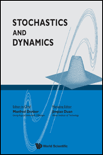
Stochastics and Dynamics
Unveiling the dynamics of stochastic processes.Stochastics and Dynamics is a premier journal published by World Scientific Publishing Co Pte Ltd, dedicated to advancing the field of Modeling and Simulation in the realm of applied mathematics. With an ISSN of 0219-4937 and an E-ISSN of 1793-6799, this journal has established itself as a vital resource for researchers and professionals seeking to explore the intricate relationship between stochastic processes and dynamic systems. Ranking in the Q2 category for 2023 within the field and positioned at rank #237 out of 324 mathematics journals according to Scopus, Stochastics and Dynamics provides high-quality, peer-reviewed articles that emphasize innovative methodologies and applications. Since its inception in 2005, the journal continues to publish pioneering research that contributes to the understanding and development of stochastic models and their dynamic behaviors, fostering knowledge that is crucial for both theoretical exploration and practical implementation. Researchers, students, and professionals will find invaluable insights and a collaborative platform within its pages, making it an essential addition to the academic community.
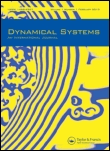
DYNAMICAL SYSTEMS-AN INTERNATIONAL JOURNAL
Bridging Disciplines through Dynamic ResearchDynamical Systems - An International Journal, published by Taylor & Francis Ltd, serves as a vital resource in the fields of mathematics and computer science applications. With an ISSN of 1468-9367 and E-ISSN 1468-9375, this journal has established a significant presence since its inception in 1996 and continues to contribute valuable insights through 2024. Although it holds a Q3 ranking in both Computer Science Applications and Mathematics (miscellaneous), it is a platform for disseminating innovative research and applications relating to dynamical systems analysis and theory. Despite recent challenges reflected in its Scopus rankings, with percentiles at the 30th and 10th for general mathematics and computer science applications respectively, the journal remains committed to fostering interdisciplinary perspectives and providing a forum for the exchange of ideas among academics, professionals, and students. Open access options ensure that research findings reach a broader audience, enhancing the journal's impact and relevance in a rapidly evolving field.

Journal of Dynamical Systems and Geometric Theories
Unraveling Complexities in Dynamical SystemsJournal of Dynamical Systems and Geometric Theories, published by TARU Publications, is a prominent platform dedicated to advancing knowledge in the fields of dynamical systems and geometric theories. With an ISSN of 1726-037X and an E-ISSN of 2169-0057, this journal serves as a vital resource for researchers, professionals, and students who are keen on exploring the complexities of mathematical models and their applications in various scientific disciplines. Though currently listed as non-open access, the journal provides robust, peer-reviewed content that is essential for fostering innovative research and development. Situated in New Delhi, India, the Journal of Dynamical Systems and Geometric Theories is committed to disseminating high-quality scholarly articles that address both theoretical and practical issues related to dynamical systems, enhancing understanding and stimulating further academic discourse. To learn more about submission guidelines and access options, please visit the journal’s official webpage.

Journal of Dynamics and Differential Equations
Connecting Theory and Application in DynamicsJournal of Dynamics and Differential Equations, published by SPRINGER, is a premier academic journal dedicated to advancing the understanding of dynamic systems and their mathematical foundations. Operating since its inception in 1989, the journal has become a vital resource for researchers and practitioners in the field, boasting a commendable Q1 ranking in the Analysis category as of 2023 and ranking #39 out of 193 journals in Mathematics Analysis on Scopus, placing it in the 80th percentile. While it maintains a traditional subscription model, its substantial contributions to the mathematics community—measured by a robust impact and adherence to high academic standards—make it essential reading for those engaged in differential equations and dynamical systems. The journal covers a broad scope of theoretical and applied research, positioning itself as a cornerstone for innovative studies and discussions, and ensuring its relevance to both contemporary and future mathematical inquiries.
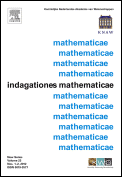
INDAGATIONES MATHEMATICAE-NEW SERIES
Advancing the frontiers of mathematical knowledge.INDAGATIONES MATHEMATICAE-NEW SERIES is a distinguished academic journal specializing in the field of mathematics, with a focus on both theoretical and applied aspects of the discipline. Published by Elsevier, a leading publisher in the scientific community, this journal has established itself as a crucial platform for the dissemination of high-quality research. With an ISSN of 0019-3577 and an E-ISSN of 1872-6100, it operates out of the Netherlands and has been a vital resource for academics since its inception in 1969. Currently, it holds a Q2 ranking in the mathematics category, signifying its relevance and impact in the field, with a Scopus rank of #222 out of 399 in General Mathematics, placing it in the 44th percentile. Although it does not currently offer Open Access options, INDAGATIONES MATHEMATICAE-NEW SERIES is committed to contributing to the advancement of mathematics by publishing original research articles, reviews, and notes that enrich the academic community. Researchers, students, and professionals alike will find invaluable insights and developments within its pages, making it a cornerstone journal for those keen on exploring the complexities of mathematics.

JOURNAL OF LIE THEORY
Unraveling the Complexities of Mathematical Relationships.JOURNAL OF LIE THEORY, published by Heldermann Verlag, is a prominent academic journal that concentrates on theoretical advancements in the realm of Lie theory, encompassing Lie algebras, Lie groups, and their applications across various branches of mathematics. Since its inception, the journal has served as a vital platform for researchers to disseminate innovative findings, contributing significantly to the field's body of knowledge. With a commitment to high-quality scholarship, the journal ranks in the Q3 quartile for Algebra and Number Theory, indicating a respectable standing within its category. Although it is not an open-access journal, the JOURNAL OF LIE THEORY remains accessible to researchers and institutions with subscriptions, fostering collaboration and knowledge exchange among mathematicians. As it continues to publish valuable research from 1996 to 2024, this journal remains a crucial resource for those interested in the intricate relationships and structures defined by Lie theory, ensuring that both seasoned academics and budding scholars can explore and expand upon the discipline's foundational concepts.

Journal of the Ramanujan Mathematical Society
Celebrating the Art and Science of MathematicsJournal of the Ramanujan Mathematical Society, published by the esteemed Ramanujan Mathematical Society, serves as a vital resource for researchers and professionals in the field of mathematics. With an ISSN of 0970-1249 and an E-ISSN of 2320-3110, this journal specializes in disseminating high-quality research and advancements in various domains of mathematics, particularly those that echo the legacy of the renowned mathematician Srinivasa Ramanujan. Since its inception in 2006, this journal has evolved to embrace a diverse range of mathematical topics, striving for excellence as evidenced by its current Q3 ranking in the mathematics (miscellaneous) category for 2023. Although it is not an open-access journal, the Journal of the Ramanujan Mathematical Society remains a cornerstone for those engaged in the academic study of mathematics, as it appears in Scopus with a rank of #343/399. As it continues its publication journey towards 2024, the journal aims to foster a vibrant community of scholars and practitioners who contribute to the evolving landscape of mathematical research.

P-Adic Numbers Ultrametric Analysis and Applications
Innovating Applications through Ultrametric InsightsP-Adic Numbers Ultrametric Analysis and Applications is a distinguished academic journal dedicated to the exploration and application of p-adic numbers and ultrametric analysis, an essential area of research within the broader field of mathematics. Published by PLEIADES PUBLISHING INC in the United States, this journal serves as a vital platform for researchers, professionals, and students alike, offering invaluable insights into both theoretical advancements and practical applications of p-adic methodologies. With its commitment to open access, the journal ensures that its content is readily available to a global audience, fostering collaboration and dissemination of knowledge. As reflected in its 2023 Q3 ranking in the mathematics category, it continues to attract a diverse range of contributions, from groundbreaking theoretical studies to innovative applied research, making it an essential resource for anyone invested in advancing their understanding of ultrametric analysis and its implications across various mathematical disciplines. Published continuously from 2009 to 2024, the journal not only encourages rigorous scholarly discussion but also emphasizes the importance of interdisciplinary approaches in addressing contemporary mathematical challenges.
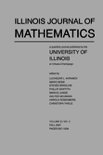
ILLINOIS JOURNAL OF MATHEMATICS
Advancing the frontiers of mathematical research.Illinois Journal of Mathematics, published by Duke University Press, is a prestigious academic journal dedicated to advancing research in the field of mathematics. Established in 1957, this journal spans decades of scholarly contributions, with a focus on innovative and original research across various mathematical disciplines. As of 2023, it holds a commendable Q2 ranking in the mathematics category, reflecting its significant impact within the academic community, with an impressive Scopus rank of #275 out of 399. The Illinois Journal of Mathematics does not currently offer open access options, yet it remains a critical resource for mathematicians, researchers, and students seeking high-quality research articles and the latest advancements in the field. With its commitment to excellence, the journal aims to foster scholarly dialogue and exploration among mathematicians, making it an essential publication for anyone passionate about mathematics.